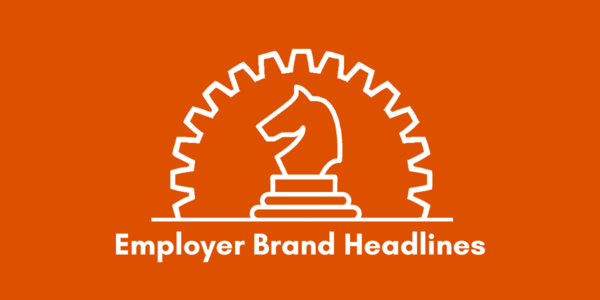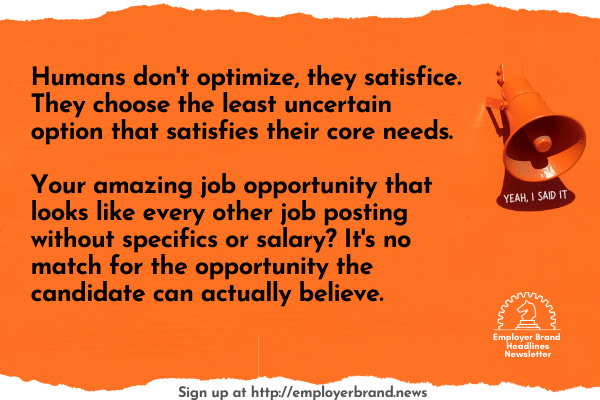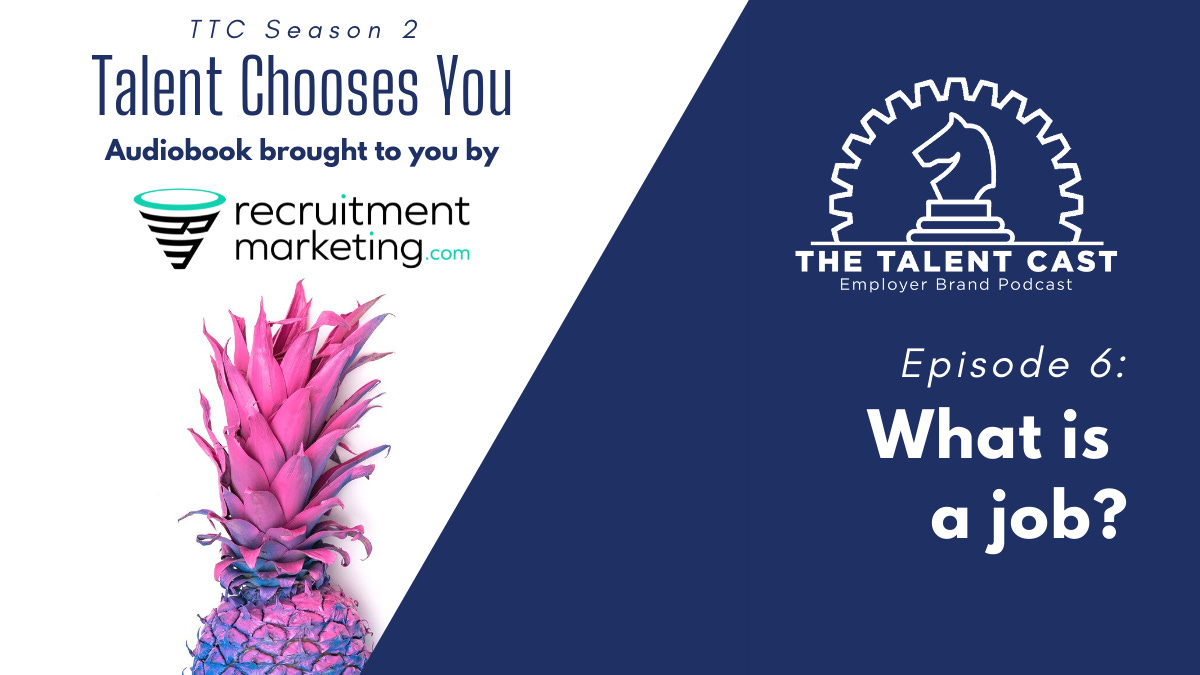💡 Employer Brand Headlines: The "Ballet for a Rainy Day" Edition (#134)
What does a perfect career site look like? You might be surprised.
My mission: move the conversation around employer brand forward.
Employer Brand Headlines, is brought to you by James Ellis.
In this issue…
The perfect career site
Employer branding supporting corporate branding
Metaverse for EB? Really???
The big idea
What’s the number one platform used by employer brand professionals? For better or worse, you’d have to agree that it is your career site, right? It’s a place you are most likely to have direct control over the narrative, if not the layout, the navigation and and content.
Lots of us are still in protracted negotiations over how much of the LinkedIn channel we’re allowed to use. Others have punted to building their own social channels from scratch (usually with a slight fraction of the corporate channel’s audience). But you don’t own those channels. You can’t call up Glassdoor and ask them to change up the layout (assuming they even both to respond). And only a fool tries to build a house on rented land. It isn’t yours, and one day, someone will yank the rug out from under you.
So if we are forced back to the career site, what does it take to maximize that platform? How do we build a truly great and effective career site?
The first step is to ask: what are you trying to achieve with your site? Are you trying to attract the most candidates and put butts in seats, or are you trying to reach quality candidates in non-commoditized roles? This isn’t me being a smartass. There are plenty of places were mass hiring is a valid approach. For the holiday season, Target and Walmart hire thousands of people to help them survive. They don’t need to hire the best shelf-stockers, just someone who’s “good enough.” Someone who shows up and does what they are told and finishes December with some cash in their pocket.
But many of us are hiring specialized roles. Even if you’re hiring for a role with lots of people to potentially apply (say, front-stack developer or nurse), you don’t want just anyone for the role, you want someone who aligns to your values, who has some semi-rare experience, someone who helps you hit your DEI targets. You want someone specific. Great.
If they are someone you want, they are likely wanted by others. That’s a safe assumption (whether or not your hiring managers have caught on yet or not). So they have a choice. And this is a major life-changing choice. So they won’t just apply simply because you have an open requisition (those days are long gone, my friends).
The goal of a career site is to inform their choice, to help a stranger project themselves into the role/team/company in a credible way so they can make a decision. So if we want to build a great career site to support a long-tail lifestyle choice, there’s a model we can steal from, one that has had 20 years of testing against very clear financial incentives: Home listings.
Look at real estate sites: there's no "buy this house now" button. They aren’t conversion driven. Instead, they know it takes a WHOLE LOT OF INFO to get people to feel comfortable in changing homes. So it offers up emotional copy to "sell/frame" the property, dozens of photos to let people see what the space feels like, a layout to help them think about where they'd put the TV or the bed, a walkthrough video, and then a LOT of meta data about the property (room measurements, school district, last year's taxes, year built, etc).
No one piece of content "sells" the house. But taken together, it paints a very clear picture, allowing the stranger believe what they are seeing/reading while they envision what it would be like to walk to that kitchen and grab some chips.
If you applied the standard career site model to home sites, you'd see two pictures (one would be an arial view courtesy of Google Earth), a paragraph of text copied from another house listing (possibly another city for all you know), zero specific details of any credibility (must be an excellent verbal communicator? What does that even mean?!) and a massive button that said, "interested in purchasing."
And you'd never sell a house.
So what’s the lesson? Humans don’t optimize, they satisfice. They choose the least uncertain option that satisfies their core needs or concerns. If you have an amazing job opportunity, but they don’t know you, if they can’t validate your fantastic claims, they will walk away to take a less amazing job who’s claims they could confirm.
Thus, your job is to create more certainty. Of the company, of the role, of the manager, and of the recruiter.
If you wanted to build a career site like a house listing, break down everything you need to know about a new role: when was the business started? How profitable is it? How fast is it growing (and phrases like "hyper growth" means nothing. You have to bring numbers to the table). Who is the manager? What’s their LinkedIn profile? How big is the team? What's the tech stack? What’s the work schedule (saying "flexible" means nothing; you HAVE to be specific)? Write it down. Then ask someone who knows how to write to explain why the job exists, why someone should want it, what kind of person should want it, etc.
I’ve seen a LOT of career sites, and I’ve seen bits and pieces of this idea implemented, but never taken all the way.
Which suggests that being the first would yield a LOT of great candidates.
Yep, we’re still podcasting about a book.
The revised and annotated audio version of Talent Chooses You (the sequel!) continues onto episode 6 where we get real and ask, “no really, what IS a job?” It may sound like a dumb question, but in the last three years, the world has been asking it a LOT.
Headlines!
Building Go-to Brands from the Inside-Out
A nice meaty article from the marketing side about how important employees are to the corporate brand. [Lippencott, via Dina Medeiros (hi, Dina!)]
5 Ways Marketing Leaders Can Drive More Value in 2022
“4. Prioritize talent issues ASAP, and don’t be afraid to try something new or radical.” If you were looking for a sign that your marketing team might be ready to hear more from you, I think this is it. [HBR]
Employees Are Sick of Being Asked to Make Moral Compromises
Welcome to the next front of employer branding: aligning moralities. [HBR]
Climb the ladder of content curation maturity
A great model for how to level up your content strategy (see also: Recruiting Content Framework) [Content Company]
The Human Face Of Intangible Assets
“80% of the value of firms lies in their intangible assets.” Those intangible assets are created and shaped by the people you hire. (Using terms like ‘intangible assets’ gets you invited to more interesting meetings at work.) [Brand Strategy Insider]
The Benefits and Risks of Rehiring a Boomerang Employee
Ye olde “great resignation” is forcing companies to look for talent in “new” places. That’s code for “auto-rejecting alumni seems like a bad idea now.” [MIT Sloan]
Jobfished: the con that tricked dozens into working for a fake design agency
By now you’ve seen this. Amazing, right? I think it speaks volumes about how little information most companies give about themselves, their work, and their existence that someone can spoof them in such a believable fashion so quickly. The lesson isn ‘t that “some people suck” (though that’s true) but that "candidates are so used to minimal credible info from real companies that a fake company can trick people.” [BBC]
Hiring is harder than ever: Here’s how Sifted readers are handling it
Color me shocked that a magazine funded by the Financial Times thinks the answer to hiring better is to increase salaries. What’s the line about to a person with a hammer, all problems look like something something? [Sifted]
Understanding Recruiting Expectations vs. Reality
A (somewhat optimistic) view that companies are starting to close the gap between what they say they care about and what they budget for. [ERE]
How the Metaverse Will Change Your Employer Brand & Workplace Culture
I, too, can’t wait to see how Facebook’s “we will sell you an ad for anything” model makes employer branding better for people. Because what your workplace culture really needed was a floating powerpoint deck you can’t look away from and internal comms’ inspirational messages blasted directly into your ears. I knew we’d have to deal with this metaverse garbage in EB eventually, but touting virtual avatars as a way to support DEI is weird take. Everything about the Metaverse screams, “why be a human when you can be a pretend human in service of your company?” [Blu Ivy]
How can marketing leaders make 2022 the year of the Great Retention?
“‘Brands need to adapt or fail, and must invest in skills, structures and people because it is the “people who will deliver against the opportunities of the next two years’.’” [econsultancy]
Inside the fortune cookie
“It’s impossible for a man to learn what he thinks he already knows.” - Epictetus
Thanks, everyone!
Search the 1,300 links in the newsletter archive.
Read Talent Chooses You for free from this open source Google Doc
Like the music? Here’s the song archive on Spotify.
If you have a question, just reply to this email and it comes directly to me.
Cheers and thanks!
-James Ellis (LinkedIn | Twitter | Podcast | Articles)
Where the subject line came from:
XTC - Ballet for a Rainy Day / 1000 Umbrellas
According to Spotify play counts, this qualifies as a “deep cut” but to me this is the perfect 1-2 punch of Andy Partridge and XTC. Complex melodies, gorgeous strings (courtesy guitarist Dave Gregory), and surprising twists and turns. Technically, these are two songs, but to me they are two sides of the same coin and must be listened to one after the other.








